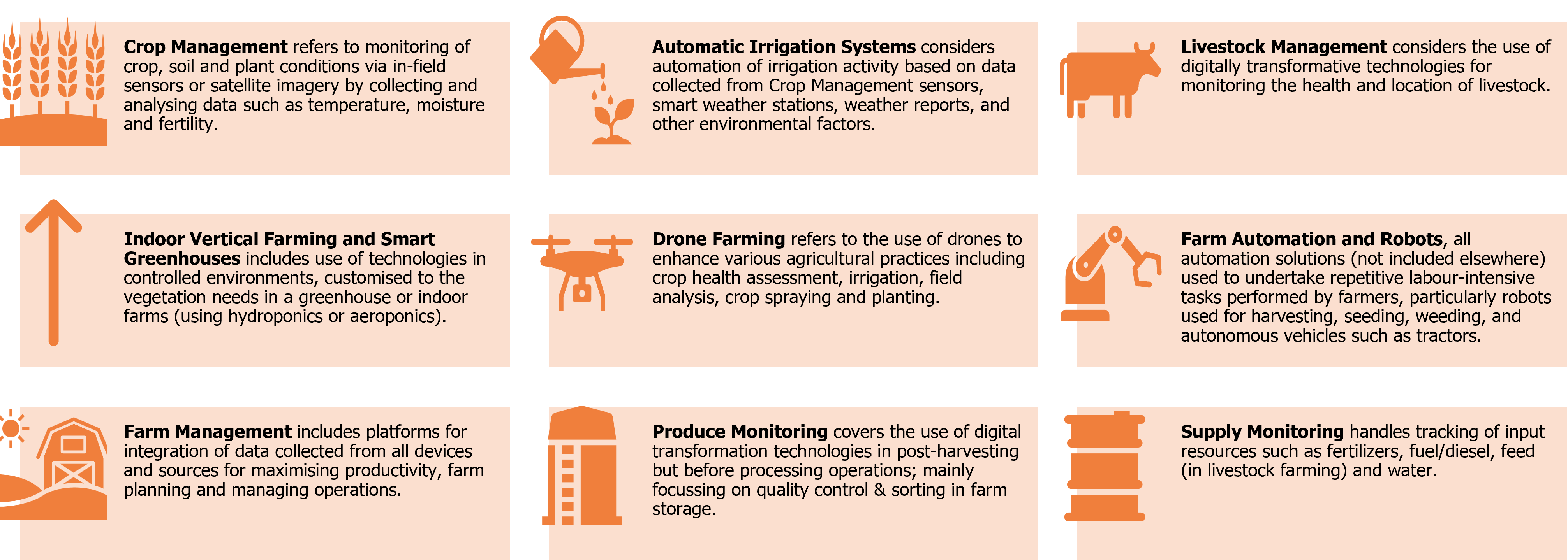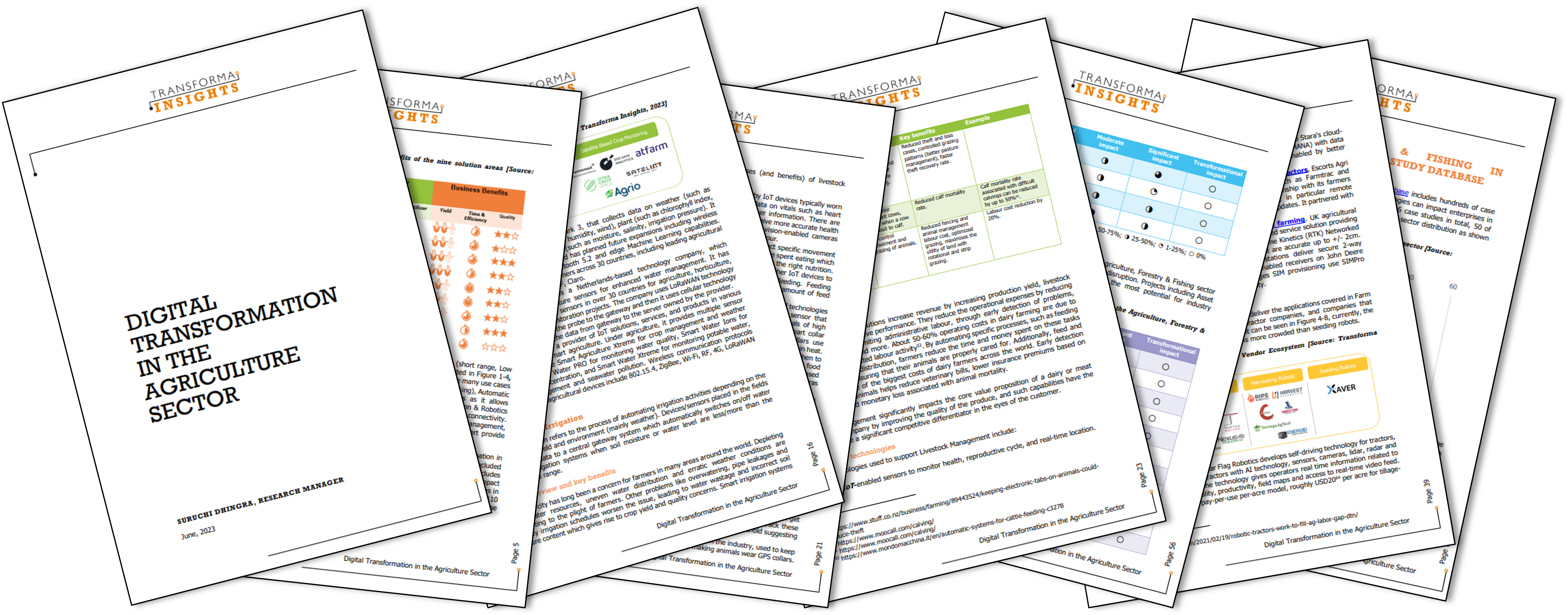Digital Transformation potential in AgTech
Digital technologies hold tremendous potential to transform the Agriculture sector by improving the efficiency of farming methods, resulting in better utilisation of resources and energy. The core driver behind rising adoption of digital technologies in this sector is the need for sustainable and consistent production, helping the industry overcome the challenge of high food demand with limited resources (especially water and land), climate change and increasing cost of labour and raw materials.
Digital transformation in Agriculture incorporates the use of granular monitoring techniques (with sensors), drones, agricultural vehicles and robots to optimise the use of resources (seed, fertilizers, water) and quickly react to threats (weeds, pests, fungi). Most of the DX solutions discussed in this document benefit businesses by improving yields, enhancing the quality of crops, improving farm productivity and reducing production costs (including labour costs). Furthermore, they significantly contribute towards sustainability goals by reducing water usage, food wastage, preventing groundwater contamination, and reducing the amount of fuel used in trips taken by farmers for monitoring fields.
Nine key domains of change in AgTech
Overall, we have identified nine key domains of change in the Agriculture sector that are enabled by digital transformation, as illustrated below.

These domains of change are discussed in more detail in our report Digital Transformation in the Agriculture Sector:

The domains of change discussed in the report comprise:
Crop Management refers to monitoring of crop, soil and plant conditions via in-field sensors or satellite imagery by collecting and analysing data such as temperature, moisture and fertility.
Automatic Irrigation Systems considers automation of irrigation activity based on data collected from Crop Management sensors, smart weather stations, weather reports, and other environmental factors.
Livestock Management considers the use of digitally transformative technologies for monitoring the health and location of livestock.
Indoor Vertical Farming and Smart Greenhouses includes use of technologies in controlled environments, customised to the vegetation needs in a greenhouse or indoor farms (using hydroponics or aeroponics).
Drone Farming refers to the use of drones to enhance various agricultural practices including crop health assessment, irrigation, field analysis, crop spraying and planting.
Farm Automation and Robots includes all automation solutions (not included elsewhere) used to undertake repetitive labour-intensive tasks performed by farmers, particularly robots used for harvesting, seeding, weeding, and autonomous vehicles such as tractors.
Farm Management includes platforms for integration of data collected from all devices and sources for maximising productivity, farm planning and managing operations.
Produce Monitoring covers the use of digital transformation technologies in post-harvesting but before processing operations; mainly focussing on quality control & sorting in farm storage.
Supply Monitoring encompasses tracking of input resources such as fertilizers, fuel/diesel, feed (in livestock farming) and water.
Collectively, the activities listed above will bring significant changes to the AgTech sector.
IoT and AgTech
IoT is one of the key technology groups impacting the Agriculture sector and further detail and analysis of key IoT applications for the Agriculture sector can be found in Transforma Insight’s Forecast Insight Reports. Some of these applications are directly relevant to the sector, whilst others are only indirectly related.
Directly related IoT applications and Forecast Insight Reports include:
-
Worker Safety
– Personal monitoring and support solutions for fire service, police, and emergency medical service personnel. Also includes lone worker safety in multiple vertical industrial contexts, particularly those involving dangerous environments such as logging and mining.
-
Asset Monitoring
– This application group encompasses a variety of assets that are suitable for remote monitoring. This includes the monitoring of livestock and associated applications such as automated feeders. It also covers the monitoring of fitness equipment located in gyms and other shared contexts. Tracking and monitoring of equipment in ambulances is also incorporated as part of the healthcare vertical.
Furthermore, this Application Group includes connected video gaming machines, gambling machines and other devices such as pachinko machines. Monitoring the condition, availability, and use of assets important to public health such as life rings and defibrillators is also present in this application group, including access to potentially dangerous infrastructure such as substations.
-
Environment Monitoring
– The use of sensors to monitor for a diverse range of pollutants or other environmental factors. This might include CO2, flood water, radioactivity, seismic shock, or pollutants from industrial processes.
-
Crop & Aquaculture Management
– This Application Group covers the monitoring of crops and agricultural land for soil condition and local environmental data. This Application Group also includes monitoring in an aquacultural context. This Application Group excludes forecast of smart irrigation and agricultural drones, which are included in the Remote Process Control and Unmanned Aquatic & Aerial Vehicles (Drones) Application Group, respectively. It excludes agricultural equipment, majorly heavy vehicles including tractors and combined harvesters, which are included in the Road Fleet Management Application Groups and excludes livestock monitoring which is included in the Asset Tracking Application Group.
-
Unmanned Non-Road Vehicles
– The Unmanned Non-Road Vehicles Application Group represents autonomous wheeled and tracked vehicles used for transporting materials, performing specific tasks or other similar activity in verticals such as agriculture, construction, mining, manufacturing, baggage handling, warehousing, space exploration or emergency response. The types of vehicles covered in this Application Group include forklifts, bomb-disposal vehicles, portside automated vehicles, straddle carriers and other specialised vehicles. Although these vehicles will not be intended for on-road use, they may be capable of travelling on public highways.
-
Remote Process Control
– Remote monitoring of equipment to manage the device in the context of a wider business process and to integrate machine data. Focused on industrial and agricultural processes. Includes factory automation, airport automation systems and baggage handling, and automated port systems. Excludes warehousing. Also part of this Application Group is crop irrigation, including connections to, and control systems for, systems that are deployed in the open air and also in closed environments such as greenhouses.
-
Unmanned Aquatic & Aerial Vehicles (Drones)
– This Application Group consists of two main categories. Unmanned Aerial Vehicles comprises fixed wing and propellor powered unmanned aerial vehicles (UAVs) for military, government consumer or commercial use. Unmanned Aquatic Vehicles comprise small underwater and surface vehicles, typically for military use or exploration. Neither vehicle is designed to carry humans; automation of vehicles that carry humans (e.g. full sized planes or ships in automation mode) is covered under autonomous vehicles.
Indirectly related IoT applications and Forecast Insight Reports include:
-
Trigger Devices
– Devices that exist to be triggered to indicate an action needs to be taken, typically something has been filled and needs to be emptied, or something is empty and needs be filled. Examples include buttons for room service, table service, the replenishment of communal supplies, mail delivery and collection boxes, and customer voting buttons.
-
Global IoT Forecast Report, 2024-2034
-
Global AIoT Forecast, 2023-2033
-
Road Fleet Management
– Road Fleet Management covers in-vehicle transportation logistics including job allocation, vehicle tracking, vehicle and driver monitoring, maintenance planning, safety compliance, fuel management, and incident management. It can be delivered as a service via a dedicated aftermarket device or through the factory-fit connectivity (accessed via the vehicle head unit). The forecast takes both heavy and light duty vehicles into consideration. It includes devices deployed in cars, vans, trucks and buses, along with heavy vehicles such as tractors, combine harvesters, pile drivers, tunnelling machines, cranes, and other off-road equipment. Fleet Management solutions are increasingly making use of in-vehicle cameras to monitor both outside the vehicle and within the cabin. These devices, and their consumer counterparts, can be found in the Dash Cams Application Group.
-
Global IoT Forecast Report, 2023-2033
-
Real World 'Visualisation'
– Includes the use of Human Machine Interface (HMI), Augmented Reality (AR), and Virtual Reality (VR) devices such as smart connected glasses, such as Microsoft’s Hololens, or Google Glass, used in either a consumer or enterprise context; standard and ruggedised tablets that can be used to access information about machinery and processes (and more); and large scale video walls, either in the context of control rooms, or to support immersive experiences. To be included in this forecast a device must be standalone, and not attached to a specific machine. Devices must also support some level of enhanced human interaction with machines (and other information, or content) rather than simply existing to relay information from a device or accept commands. Beyond this scope lie innumerable generic tablets, laptops, mobile phones, and other computing devices that can also support some aspects of HMI by simple installation of an application (or access to suitable web pages).
Other content and related analysis
Besides the detailed sector-focussed content described above, Transforma Insights offers an extensive range of thematic- and vendor-focussed research that will prove invaluable to any end-user seeking to leverage new and emerging digitally transformative technologies.
Of particular note are our Vendor Insight and CSP Peer Benchmarking reports, which provide detailed profiles of leading vendors who might be able to support a range of end-user digital transformation projects.
Our Key Topic Insight reports focus on the qualitative aspects of Digital Transformation, including investigation of interesting or noteworthy topics.
Detailed analysis of regulations that might apply to digitally transformative projects around the world can be found in our Regulatory Database. Meanwhile, our Case Study Database contains more than 1,000 case studies of technology implementations. Each case study contains detailed information on the specifics of the deployment. Used in aggregate it can provide unrivalled guidance on project prioritisation, best practice and vendor selection.